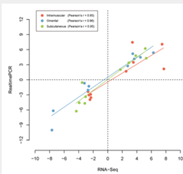Adipocytes mainly function as energy storage and endocrine cells. Adipose tissues showed the biological and genetic difference based on their depots. The difference of adipocytes between depots might be influenced by the inherent genetic programing for adipogenesis. We used RNA-seq technique to investigate the transcriptomes in 3 adipose tissues of omental (O), subcutaneous (S) and intramuscular (I) fats in cattle. Sequence reads were obtained from Illumina HiSeq2000 and mapped to the bovine genome using Tophat2. Differentially expressed genes (DEG) between adipose tissues were detected by EdgeR. We identified 5797, 2156, and 5455 DEGs in the comparison between OI, OS, and IS respectively and also found 5657 DEGs in the comparison between the intramuscular and the combined omental and subcutaneous fats (C) (FDR<0.01). Depot specifically up- and down- regulated DEGs were 853 in S, 48 in I, and 979 in O. The numbers of DEGs and functional annotation studies suggested that I had the different genetic profile compared to other two adipose tissues. In I, DEGs involved in the developmental process (eg. EGR2, FAS, and KLF7) were up-regulated and those in the immune system process were down-regulated. Many DEGs from the adipose tissues were enriched in the various GO terms of developmental process and KEGG pathway analysis showed that the ECM-receptor interaction was one of commonly enriched pathways in all of the 3 adipose tissues and also functioned as a sub-pathway of other enriched pathways. However, genes involved in the ECM-receptor interaction were differentially regulated depending on the depots. Collagens, main ECM constituents, were significantly up-regulated in S and integrins, transmembrane receptors, were up-regulated in I. Different laminins were up-regulated in the different depots. This comparative transcriptome analysis of three adipose tissues suggested that the interactions between ECM components and transmembrane receptors of fat cells depend on the depot specific adipogenesis.


